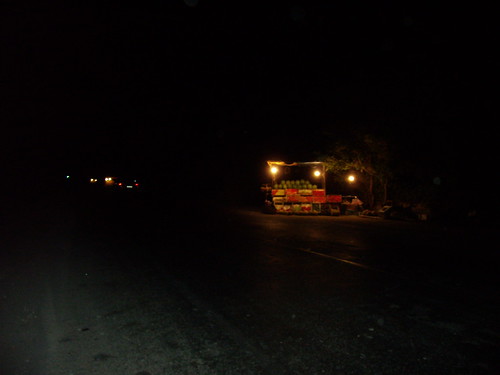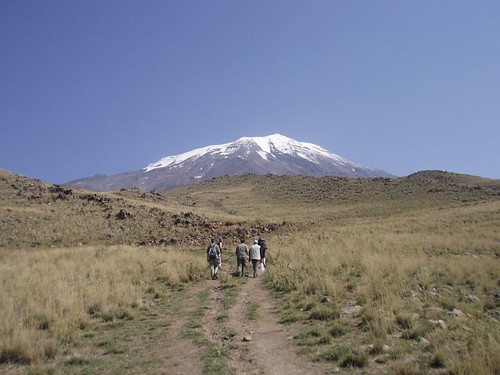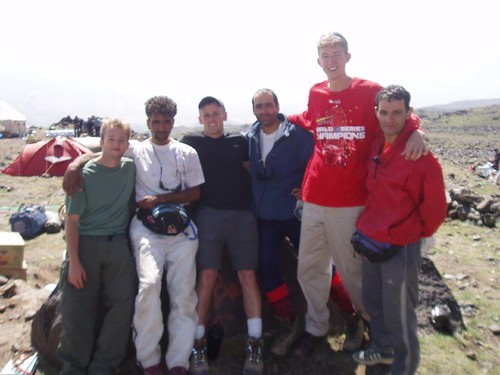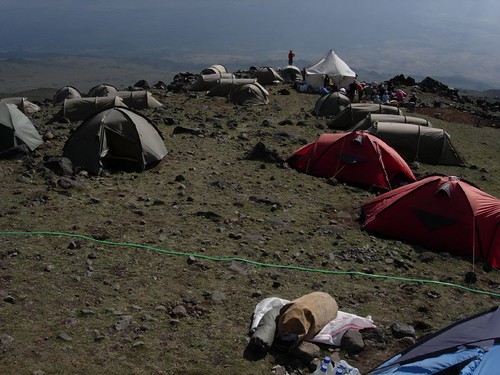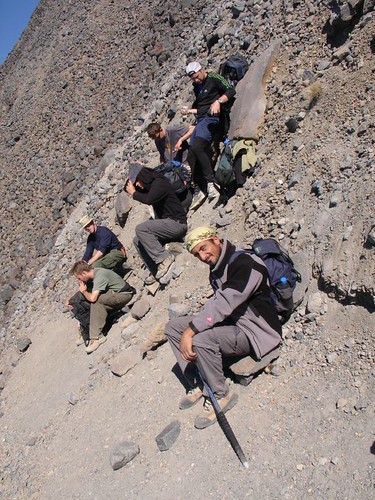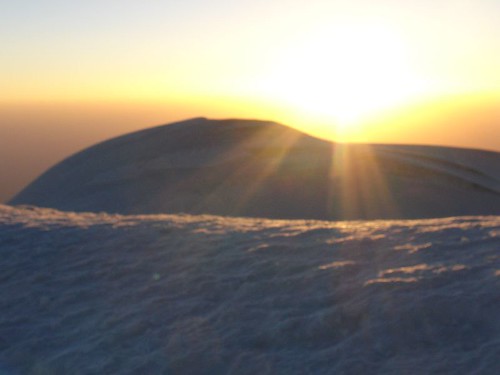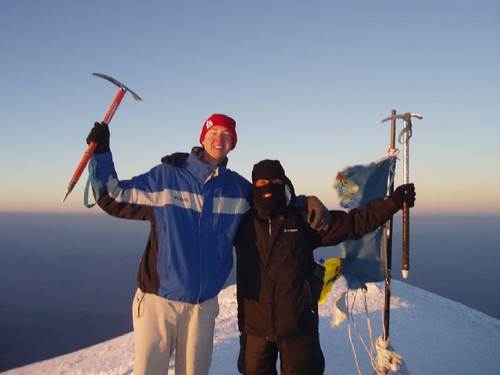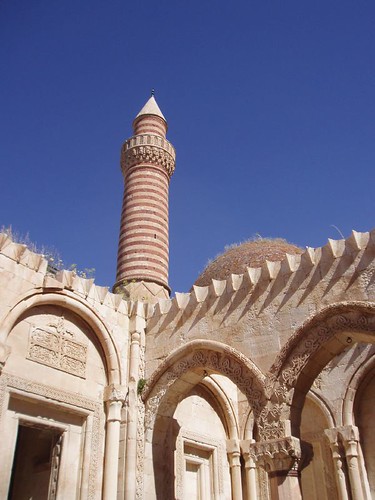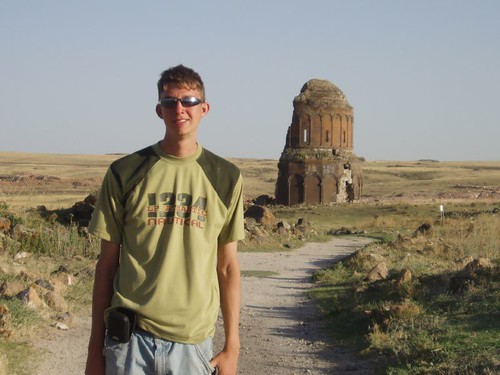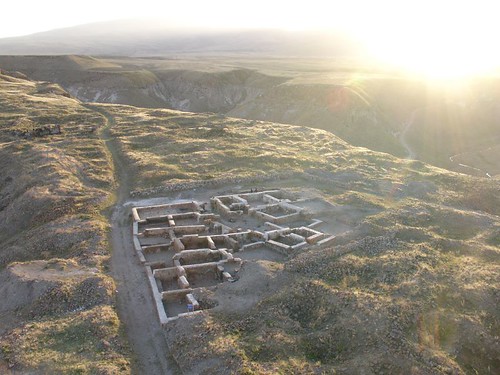…can turn pretty slow sometimes, especially in these parts. I’m not usually one to complain about my conditions, especially my transportation options. After all, they’re not that bad here in Armenia. After all, I could be riding next to livestock, or even worse, on livestock. We have three main options to get to and fro Noyemberyan – shared taxis, public mini-buses (called “marshutnis”), and the bus. Shared taxis are the best option, and let you ride through the hills in a comfortable, yet stylish, 1980s Lada; they also the most expensive. Marshutnis are the main option, offering a good balance between cost and comfort. Think of the conversion van you or your parents might have had in 1986 and cram 18 people in it – still not that bad, right?
Today I returned from my second home, Vanadzor, and decided to “treat” myself to the third option, the public bus. The Armenian bus looks like a giant orange Tic-Tac – they are actually old Soviet buses which have not been painted/cleaned/maintained since 1989. Come to think of it, riding in one is a lot like riding on the aforementioned livestock – it goes about as slow – but without the benefits of the leg room or normal conversation. One of my favorite travel writers, Bill Bryson, gives a pretty good description of public buses in his book, “The Lost Continent”:
You only go on a long-distance bus in the United States because either you cannot afford to fly or – and this is really licking the bottom of the barrel in America – you cannot afford a car. Being unable to afforda a car in America is the last step before living out of a plastic sack. As a result, most of the people on long-distance buses are one of the following: mentally defective, actively schizoid, armed and dangerous, in a drugged stupor, just released from prisons, or nuns. Occasionally you will also see a pair of Norwegian students.
Substitute “Peace Corps Volunteers” for “Norwegian students”, and you’ve also captured the Armenian bus system. Most people who have the money take their cars, cabs, or marshutnis; those who don’t take the bus. These buses have seats for 24. In reality, they can hold 73 people, 12 chickens, 28 bags of potatos, 6 screaming children, and at least two people playing their cell phone music outloud for everyone to hear (at the same time).
Our Noyemberyan bus is first-on-first-sit, and since we were only 30 minutes early today, we were left standing. I assumed my usual position by the rear door, standing on the first step, as this is the only spot where I have enough a) leg-room and b) head-room. You also get to meet-and-greet the people getting on and off. This average person can either be an older farm woman, wearing a tattered men’s sport coat and carrying a bag of spinach and empty bottles, or a 22 year old boy, dressed in various shades of grey head to toe, muttering “tsavd tanem” to himself. However, each has a very unique smell, which can change the aroma from old cheese to homeade vodka from stop to stop. Alex chose the aisle. Being a little over 5ft tall, he was quickly swallowed by the crowds; come to think of it, I’m not sure he actually made it off the bus today.
The ride itself takes 3.5 hours, or 133% longer than the marshutni ride of the same distance, and served no less than 120 people. For me, it is a humbling experience and reminds me I really am in the Peace Corps, that I really will be able to go back to America and live through anything, and that I really am rediculously tall. We finally made it home, and I was so thankful to be back. So, next time you’re stuck stranded on the Greyhound (Lukin?), remember it could be a lot worse. I know I will.
——————-
P.S. Don’t let this rather insignificant post bump what I wrote about below – if you haven’t read it yet, please scroll down!
The last twenty-four hours have been somewhat interesting in this part of the world. Not just because the price of cooking oil just doubled, and because watermelon is almost out of season, but just by looking at the headlines you can probably figure it out:
“House Pens Resolution on Armenian Genocide”
“Turkey Recalls Ambassador After US Armenian Vote”
“President Bush ‘Disappointed’ by Passage of Armenia Genocide”
“Turkey mulls cutting military ties with US over genocide vote”
To summarize, “The House of Representatives foreign affairs committee has approved a non-binding resolution calling the massacre of Armenians nearly a century ago a genocide. The vote was 27 to 21.” The Executive branch is angry, Turkey is livid, the democrats are giddy, the Armenians thrilled, and the average American – probably just confused.
Because of my rather unique job title as a Peace Corps Volunteer, the government can keep us on a tight leash. We are not officially employees, so we don’t get any of the real perks (I guarantee I get paid lower than minimum wage 😉 ), but because we still “represent” the Peace Corps, they have every right to tell us what our “official” positions are on political issues such as this. So, please, Peace Corps-Washington censor, know this is about scholarship, not the politics.
Most Americans only hear about the Armenian _________ on April 24th, when it is officially mourned around the world, including by our own President Bush. Living here, it’s one of the questions I’m asked about on a near daily basis (along with why I’m not married): “Have you heard about the Armenian Genocide?” and “Why does the US Government not recognize it?” Because of the connection I have with it just by living here, it’s a much more emotional issue for me, and one that goes beyond the strategic military importance of American-Turkish relations. To the people I live with on a daily basis, it deals with the possibility of the extermination of their entire race, their language, their culture – that’s pretty heavy stuff.
I hope people come to this blog to be educated about this lil’ Christian country and what role it has in the world. This is a perfect example. If we really want to use the freedoms we’ve been given, fight the axis of evil, whatever, we need to educate ourselves. So please read up on the issue, and make your own decisions about where you stand. I will gladly sit with and discuss it ad nauseum when I come home. But whatever you do, please don’t remain ignorant about this world issue, because as the Dalai Lama says, “Where ignorance is our master, there is no possibility of real peace.” So please, read up:
- Google News coverage – links to 600+ news articles about the resolution
- WikiPedia article on the Genocide – probably the closest thing you’ll find to an unbiased read on the Internet
- Burning Tigris – a great book about it all
Happy scholarship! 😉
My vacation to Turkey was really nice – it was very relaxing and felt like a real vacation. Because of this, the last 3 weeks here have been extremely busy, and it looks like there won’t be much downtime until I leave for Greece in November. So for those of you I haven’t written back in a while… sorry, this week I promise!
Right now I’m on the road – in between an IOC meeting on Sunday and a seminar I will deliver to teachers about integrating technology, I went to my friend Sarah Z’s village (she has a blog, too) to continue our marathon training with an 18 mile run (ugh!). Unfortunately, between late meetings and slow public buses, we didn’t get to her village until about 7 pm. At about 8, we started our run, which took about 3 hours – most of which was in the pitch black on a major highway. The first 12 miles were a piece of cake until the last 6, when we decided to run on the only lit section of road, a half-mile stretch of 24-hour fruit stands.
These stands are open all night, and there are actually beds and televisions out for the workers. It should be noted that each stand sells the EXACT same things, and there is nothing to differentiate one from the other. So, for one hour, we ran next to these stands and gradually developed a cheering session. Most people were just thouroughly confused, which I think can be summed up by Sarah’s quote, “The only thing funnier than the two of us running up and down this street lined with fruit stands is your shorts.” Yes, they are short, and I am tall, and this is funny to many Armenians. We finally made it though, and while I couldn’t stand up most of the rest of the night, I’m only a month away from running 26 miles through the heart of Athens! Here are some pictures of the fruit stands, and some of Sarah’s quotes she asked me to post:
“If we can train here…”
“It fits right in, it’s just like we’re littering.”
“I bet these socks won’t be white ever again.”
“I’m going to get a reputation in Ararat.” “You told them your name?!”
If you don’t understand all of these, it’s ok, neither do I. Anyway, If you only want to hear a random anecedote about my marathon training, you can stop here. If you’re actually interested at what I’m doing here, please click the link below to read on.
(more…)
As most (Christians) know, Mt. Ararat in south-eastern Turkey is the supposed location of Noah’s Ark. For the Armenian people, it is also their national symbol, and is a token for the vast empires of the past and a beacon of hope1 for their future. Plus, it just looks really great in the background of pictures of Armenian churches and Yerevan. For all these reasons, along with some much needed vacation time, we left Armenia on September 2nd for a hike up the biggest mountain in Europe.
Six of us, all PCVs, went on the hike. We left Gyumri early in the morning via chartered mini-bus, and arrived at the base of the mountain a mere 14 hours later (covering a net 30km from the closed Turkish-Armenian border). The hike was to take 5 days, and after our last (and first, really) night with hot showers and comfy beds, we set off for the mountain. Ararat is composed of two mountains, the baby, Sis (or Kuchuk Agri in Turkish), and Masis (Buyuk Agri), the 16,700 ft monster we were to climb. Climbing required a guide and permission of the government, and we worked with a local agency called Tamaza Trek (highly recommended!). They provided us with all of the food, tents, etc and really made the hike a great experience.
The first three days were spent hiking up and down from the first camp, located around 3200m as acclimatization hikes. During that time, we met a lot of great people from other countries, including my first experiences with native Iranians. Everyone was genuinely nice and especially interested to meet Americans, who they rarely see in this part of the world without a military uniform on. The Iranian group was hiking parallel to us (as in, would summit the same day) and kept everyone entertained (or wearing headphones) most of the day with their songs. Certainly the most entertaining and kind “Axis of Evil” members I could hope to meet.
The fourth day, September 8th, would be the big day to summit. We left at 2 in the morning (which isn’t such a big deal when you’re going to sleep at sunset – 7pm – every day), with the Iranians in the lead by about a half hour. Being good Americans, we shoved our way to the front and reached the summit around 5:30am, right as the sun was rising over snow-capped peaks. Words are tough to describe it, but I think “beautiful but bitterly cold” about sums it up. We were in full mountain gear, long underwear and all, but even with that the wind was overwhelming. We stayed on top for 30 minutes, took as many cheesy pictures as possible before frostbite hit, and began our decent down to the first camp. It was a very long, but certainly unforgettable day.
The last day we woke up bright and early (again, 5am) so that we could do some tourist things in the area. Since there was one more group going up that day, our guide decided to stay and sent the cook to take us to the vans. The cook was a great guy – Kurdish, very lively, and many songs about guerrillas – but I’m pretty sure he’s not all there. He insisted on singing for the first hour until he got noticeably quieter. Puzzled, we soon learned he had taken a wrong turn and we were now over 5 miles off-course from the road. The next 4 hours were much more somber as we climbed rock faces, hurdled ravines and trudged into a Kurdish village, where the greatest development tool of them all, the cell phone, saved the day once again.
Once we finally made it off the mountain, we visited the Ichka Pasha Palace, which overlooked the Silk Road in Byzantine times. It was nice, but we really wanted to see the old Armenian capital city of Ani. We managed to arrive outside of the city gates at 4:55, a mere 5 minutes before closing time. After some begging, pleading, and maybe slipping a Lira or two in the guard’s pocket, they gave us one hour to “power tour” the city.
Ani is a very interesting place – it was the Armenian capital until about 1100 AD, when it was ransacked by everyone from the Byzantines to the Mongols. It once stood as a center of commerce, trade and religion for Armenia (they call it the city of 1000 churches), and about 100,000 people lived there. Today, it is no more than ruins with a few signs, but would certainly be an archeologists dream.
Overall, the trip was great and we had a wonderful time. All of our Armenian friends are proud that we made it and glad that we were able to learn so much about Armenian history in the process. So am I! I have posted most of the good pictures in the photo album page, and my friend Laszlo also put his account and pictures on his webpage. And to answer your burning question: no, we didn’t find the Ark.
Now I am back at site, ready to resume work until November 2nd, when I leave to run the Athens Classic Marathon! Today I ran 16 miles, a new personal best for me. I would also like to thank everyone who has contributed to my “Push to the Finish” campaign – so far we’ve raised almost $1,000 for people with disabilities!! Keep it up and please pass the word to your friends and families so I can reach my $2,000 goal.
